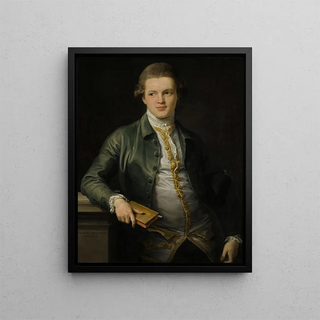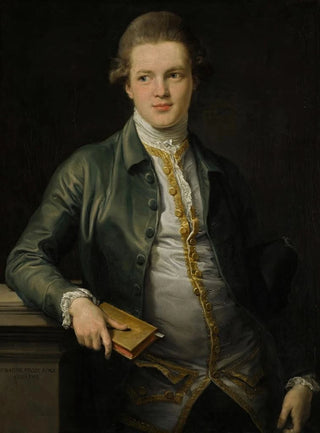Art print | Portrait of Thomas Orde, later Orde-Powlett and 1st Baron Bolton - Pompeo Batoni


View from behind

Frame (optional)
The portrait of Thomas Orde, later Orde-Powlett and 1st Baron Bolton, created by the Italian artist Pompeo Batoni, is an iconic work that embodies the values and aspirations of 18th-century British nobility. This painting, depicting a man with a contemplative face and elegant attire, immerses us in an era where art and society were closely intertwined. Through this artwork, Batoni does not merely portray his subject but invites us to explore the nuances of his character and social status. The art print of this portrait allows appreciation of the artist's finesse and offers a glimpse into the fascinating world of the aristocracy of his time.
Style and uniqueness of the work
Batoni's style is distinguished by its refined approach and attention to detail, characteristic of the Rococo movement. In this portrait, light plays a fundamental role, illuminating Thomas Orde's face while creating a soft, intimate atmosphere. The colors are carefully chosen, oscillating between warm tones and cooler shades, giving the work unprecedented depth. The drapery of his costume, meticulously painted, testifies to Batoni's skill in capturing the texture of fabrics. This portrait stands out for its ability to reveal the personality of its subject while respecting the conventions of the period. The penetrating gaze of Thomas Orde, combined with a confident posture, evokes both dignity and intelligence—qualities highly valued among members of high society.
The artist and his influence
Pompeo Batoni, born in Lucca in 1708, is one of the most influential portraitists of his time. His career, spanning several decades, is marked by numerous commissions from prominent personalities, both in Italy and abroad. Batoni successfully combined the tradition of classical portraiture with a more modern approach, incorporating elements of English culture into his work. His style not only influenced his contemporaries but also left a lasting imprint on subsequent generations.

Matte finish

View from behind

Frame (optional)
The portrait of Thomas Orde, later Orde-Powlett and 1st Baron Bolton, created by the Italian artist Pompeo Batoni, is an iconic work that embodies the values and aspirations of 18th-century British nobility. This painting, depicting a man with a contemplative face and elegant attire, immerses us in an era where art and society were closely intertwined. Through this artwork, Batoni does not merely portray his subject but invites us to explore the nuances of his character and social status. The art print of this portrait allows appreciation of the artist's finesse and offers a glimpse into the fascinating world of the aristocracy of his time.
Style and uniqueness of the work
Batoni's style is distinguished by its refined approach and attention to detail, characteristic of the Rococo movement. In this portrait, light plays a fundamental role, illuminating Thomas Orde's face while creating a soft, intimate atmosphere. The colors are carefully chosen, oscillating between warm tones and cooler shades, giving the work unprecedented depth. The drapery of his costume, meticulously painted, testifies to Batoni's skill in capturing the texture of fabrics. This portrait stands out for its ability to reveal the personality of its subject while respecting the conventions of the period. The penetrating gaze of Thomas Orde, combined with a confident posture, evokes both dignity and intelligence—qualities highly valued among members of high society.
The artist and his influence
Pompeo Batoni, born in Lucca in 1708, is one of the most influential portraitists of his time. His career, spanning several decades, is marked by numerous commissions from prominent personalities, both in Italy and abroad. Batoni successfully combined the tradition of classical portraiture with a more modern approach, incorporating elements of English culture into his work. His style not only influenced his contemporaries but also left a lasting imprint on subsequent generations.






